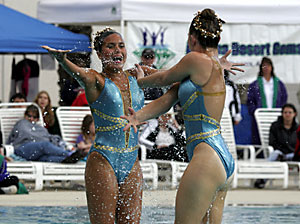 |
|
JACOB KONST/Arizona Daily Wildcat
|
Freshman Alexandra Salas and junior Kirstin Schnepp splash their way out of the water during Sunday's meet. The Splashcats hosted the Arizona State Championship held at the Student Recreation Center.
|
|
|
By Marcia Gaysue
Arizona Daily Wildcat
Tuesday, February 8, 2005
Print this
Arizona sports fans might remember 1980 as the year the baseball team won its first national championship, but it's also the year the Arizona synchronized swimming team earned its first national title.
The Splashcats won two more national championships in '81 and '84, but due to the financial problems the athletic department was having in the mid-'80s, many sports were cut, including synchronize swimming.
Although the ninth-ranked Splashcats are back in the pool, they are only recognized as a club team, making it hard for them to cover the expenses often associated with an athletic team. Many of the swimmers have to use their own money and conduct fundraisers to cover all the expenses, ranging from travel to equipment.
"It's basically ran by the dedication of the swimmers, because if we weren't dedicated, we wouldn't be able to put money into it," said senior team captain Michelle Meyer. "We have to put in a lot of extra time and work just to be able to swim, and I think that we could actually be a lot better if we had someone else doing all the little work for us."
Last year, National Synchronized Swimming spoke with the athletic directors to make synchronized swimming a varsity sport again. Ultimately, the directors decided that the UA is not ready for the program because the school does not have an adequate facility to host events for the Splashcats.
"There's no deep water pool anymore. They got rid of Giddings and Hillenbrand (Aquatic Center) is not suitable for the sport," said Splashcat head coach Jill Ranucci. "It would be a matter of having a deep water pool built and then re-approaching the subject."
Some of the Splashcats like the idea of synchronized swimming becoming a varsity sport because they believe it would provide more fan support.
In 1998, the Splashcats received their revival from Ranucci, who's been coaching for more than 25 years. She has been able to rebuild the program into one of the premiere club teams in the country without the benefit of giving out scholarships like some of the national synchronized swimming powerhouses.
Ranucci said the team has to rely on the prestige of the university to sell itself to girls interested in the school.
"Here it's still club, so you're not going to see the swimmers that come from here go to the Olympics because Division-I schools like Ohio State, Stanford and Alabama have recruiting tools," Ranucci said. "They're the ones that recruit the national team athletes because they can give them full rides and I can't."
Alexandra Salas, a freshman swimmer from Peru, chose the UA based on the value of education.
"I was looking for a school that had synchro and I found U of A and I thought it was a good team, and I think they have a good program in business management, so I applied here and got a scholarship," Salas said.
In the fall semester, Salas received a 4.0 grade point average.
Despite not being scholarship athletes, the team is able to maintain a 3.38 GPA.
"I'm really big on academics," Ranucci said. "They come to school here for a degree, and they don't offer a degree here in synchro swimming."
This weekend the Splashcats hosted the Arizona State Championship, which included an all-level competition, from beginning synchronized swimming up to the collegiate level. After defeating the second-ranked Stanford Cardinal two weeks ago, the team was able to use this meet to correct mistakes.
"This weekend allowed us to know what direction we need to go in, with some of the things we need to change, some of the things we need to adjust, and of course some of the things we need to polish even better to be perfect," Ranucci said.
Meyer received two medals while Salas took home four gold medals in the event.
